Masaccio (1401-1428)
Get a Masaccio Certificate of Authenticity for your painting (COA) for your Masaccio drawing.
For all your Masaccio artworks you need a Certificate of Authenticity (COA) in order to sell, to insure or to donate for a tax deduction.
Getting a Masaccio Certificate of Authenticity (COA) is easy. Just send us photos and dimensions and tell us what you know about the origin or history of your Masaccio painting or drawing.
If you want to sell your Masaccio painting or drawing use our selling services. We offer Masaccio selling help, selling advice, private treaty sales and full brokerage.
We have been authenticating Masaccio and issuing certificates of authenticity since 2002. We are recognized Masaccio experts and Masaccio certified appraisers. We issue COAs and appraisals for all Masaccio artworks.
Our Masaccio paintings and drawings authentications are accepted and respected worldwide.
Each COA is backed by in-depth research and analysis authentication reports.
The Masaccio certificates of authenticity we issue are based on solid, reliable and fully referenced art investigations, authentication research, analytical work and forensic studies.
We are available to examine your Masaccio painting or drawing anywhere in the world.
You will generally receive your certificates of authenticity and authentication report within two weeks. Some complicated cases with difficult to research Masaccio paintings or drawings take longer.
Our clients include Masaccio collectors, investors, tax authorities, insurance adjusters, appraisers, valuers, auctioneers, Federal agencies and many law firms.
We perform Masaccio art authentication, appraisal, certificates of authenticity (COA), analysis, research, scientific tests, full art authentications. We will help you sell your Masaccio or we will sell it for you.
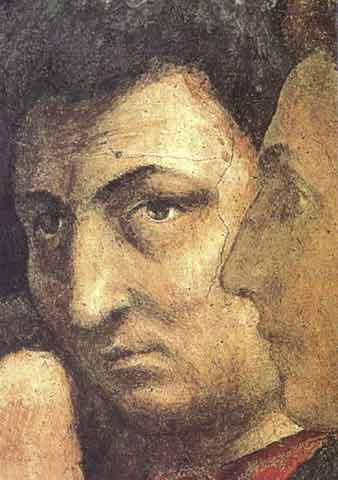
Masaccio, born Tommaso Cassai or in some accounts Tommaso di Ser Giovanni di Mone, was the first great painter of the Italian Renaissance. His frescoes are the earliest monuments of Humanism, and introduce a plasticity previously unseen in figure painting.
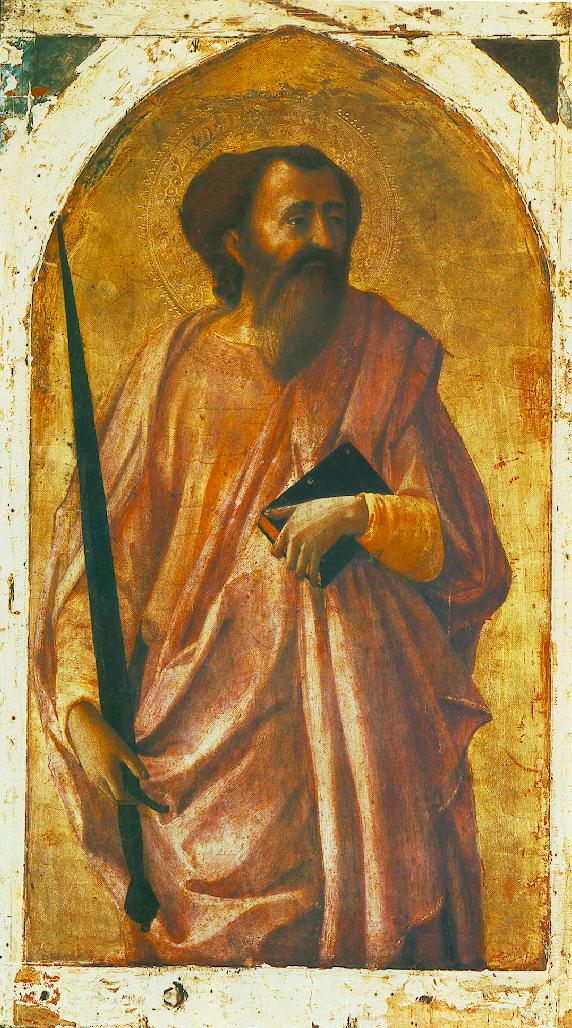
The name Masaccio is a humorous version of Tommaso, meaning “big”, “clumsy” or “messy” Tom. The name was created to distinguish him from his principal collaborator, also called Tommaso, who came to be known as Masolino (“little/delicate Tom”).
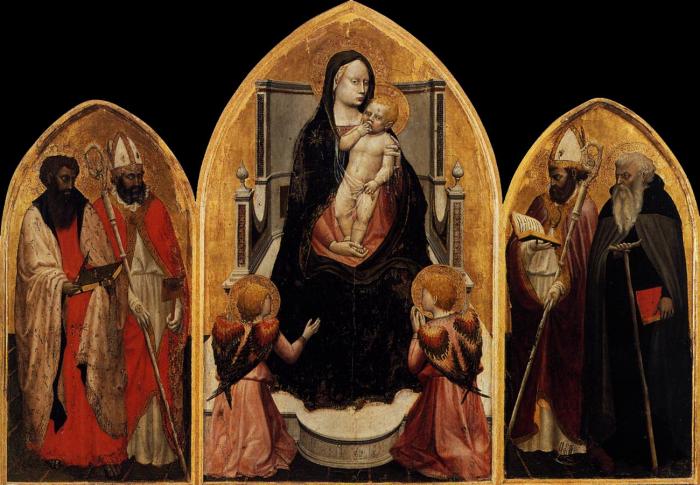
Despite his brief career, he had a profound influence on other artists. He was one of the first to use scientific perspective in his painting. He also moved away from the Gothic style and elaborate ornamentation of artists like Gentile da Fabriano to a more naturalistic mode which employed perspective for greater realism.
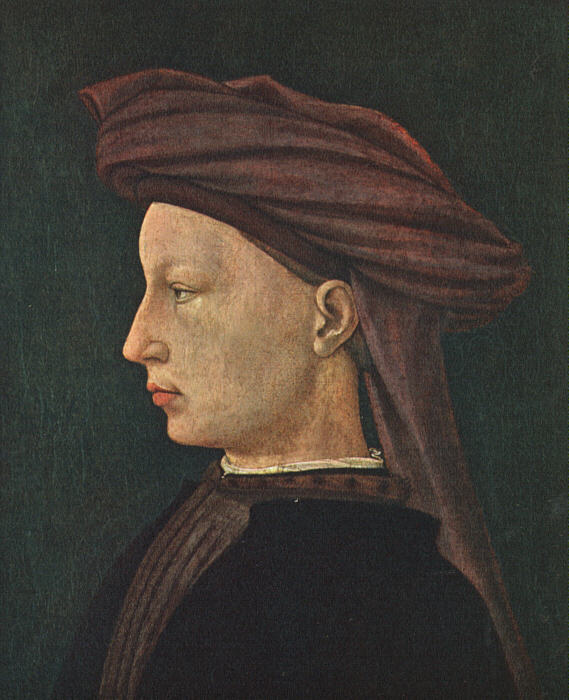
Masaccio was born to Giovanni di Mone Cassai and Jacopa di Martinozzo in Castel San Giovanni di Altura, now San Giovanni Valdarno (now part of the province of Arezzo, Tuscany). His father was a notary and his mother the daughter of an innkeeper of Barberino di Mugello, a town a few miles south of Florence. His family name, Cassai, comes from the trade of his grandfather Simone and granduncle Lorenzo, who were carpenters – cabinet makers (“casse”, hence “cassai”). His father died in 1406, when Tommaso was only five; in that year another brother was born, called Giovanni after the dead father. He also was to become a painter, with the nickname of “Scheggia”. The mother was remarried to an elderly apothecary, Tedesco, who guaranteed Masaccio and his family a comfortable childhood.
The family probably moved to Florence at the death of Tedesco, in August 1417. Little is known about this period until Tommaso joined one of the seven main craft’s guilds in Florence, on January 7, 1422, signing as “Masus S. Johannis Simonis pictor populi S. Nicholae de Florentia”. In the new city Tommaso received his nickname, meaning “Clumsy Thomas” for the little care he gave to wordly affairs and to personal appearance: otherwise he was considered a good-natured person.
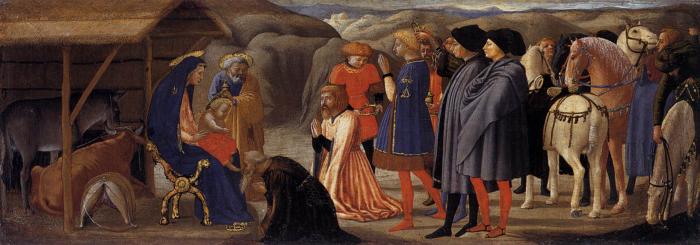
The first works attributed to Masaccio are the Cascia Altarpiece, (1422), picturing the Madonna enthroned with angels and saints, and a Virgin and Child with St. Anne, (ca. 1424) at the Uffizi: they are already works of very high quality. The second work was a collaboration with an older and already renowned artist, Masolino da Panicale, and for many years it was assumed Masaccio was simply an apprentice to Masolino. More recently it has been noted that Masaccio gained entry to the Painters’ Guild before Masolino, suggesting that their collaboration was for convenience or simply moved by mutual esteem. Masaccio’s talent was apparent, and was probably already superior to that of Masolino. The source of the younger master’s education remains an enigma; it is still not known where Massaccio received his training in art.
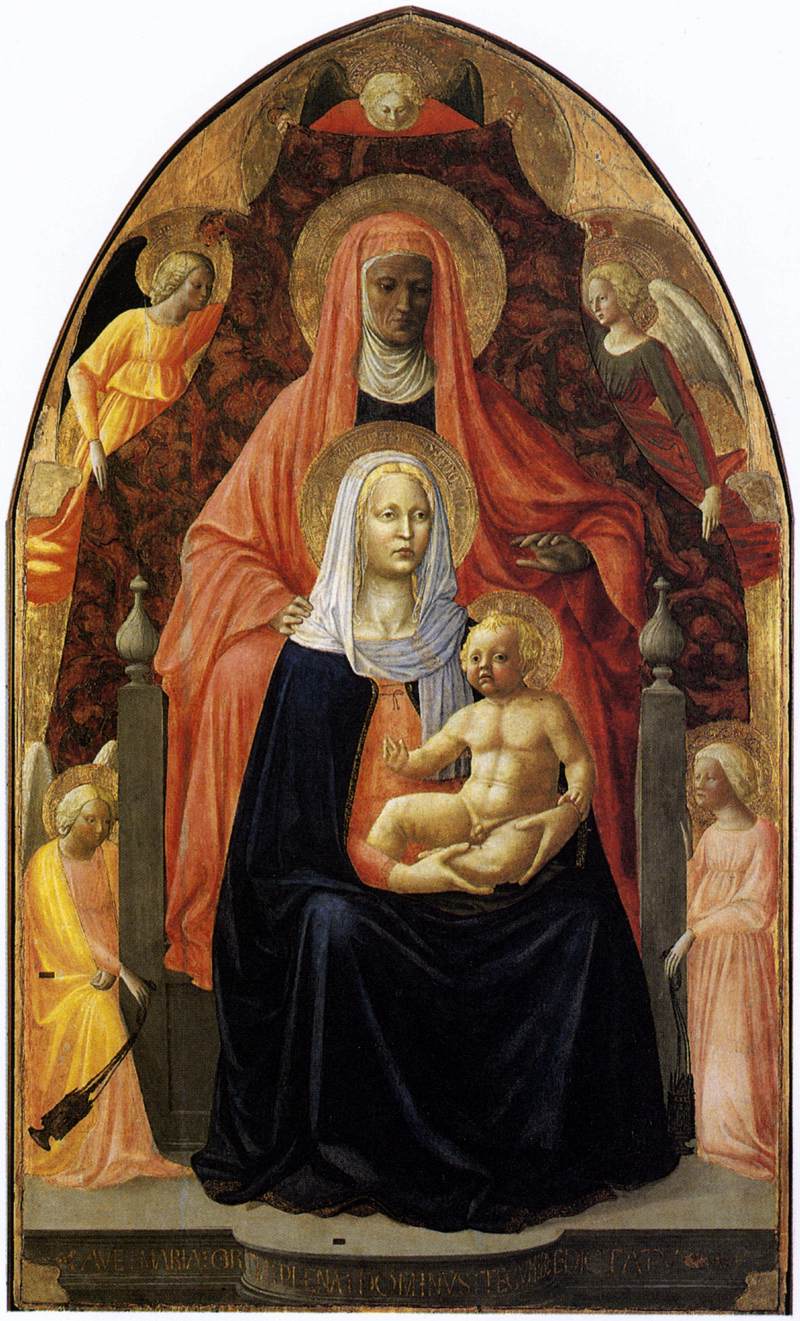
In Florence, Masaccio could study the works of Giotto and become friends with Alberti, Brunelleschi and Donatello. According to Vasari, at their prompting in 1423 Masaccio travelled to Rome with Masolino: from that point he is freed of all Gothic and Byzantine influence, as may be seen in his altarpiece for the Carmelite Church in Pisa, the central panel of which (The Madonna and the Child) is now in the National Gallery, London. As well as a sculptural and human Madonna the work features a convincing perspectival depiction of her throne. The traces of influences from ancient Roman and Greek art that are present in some of Masaccio’s works presumably originated from this trip: they should also have been present in a lost Sagra, (today known through some drawings, including one by Michelangelo), a fresco commissioned for the consecration ceremony of the church of Santa Maria del Carmine in Florence (April 19, 1422). It was destroyed when the church’s cloister was rebuilt at the end of the 16th century.
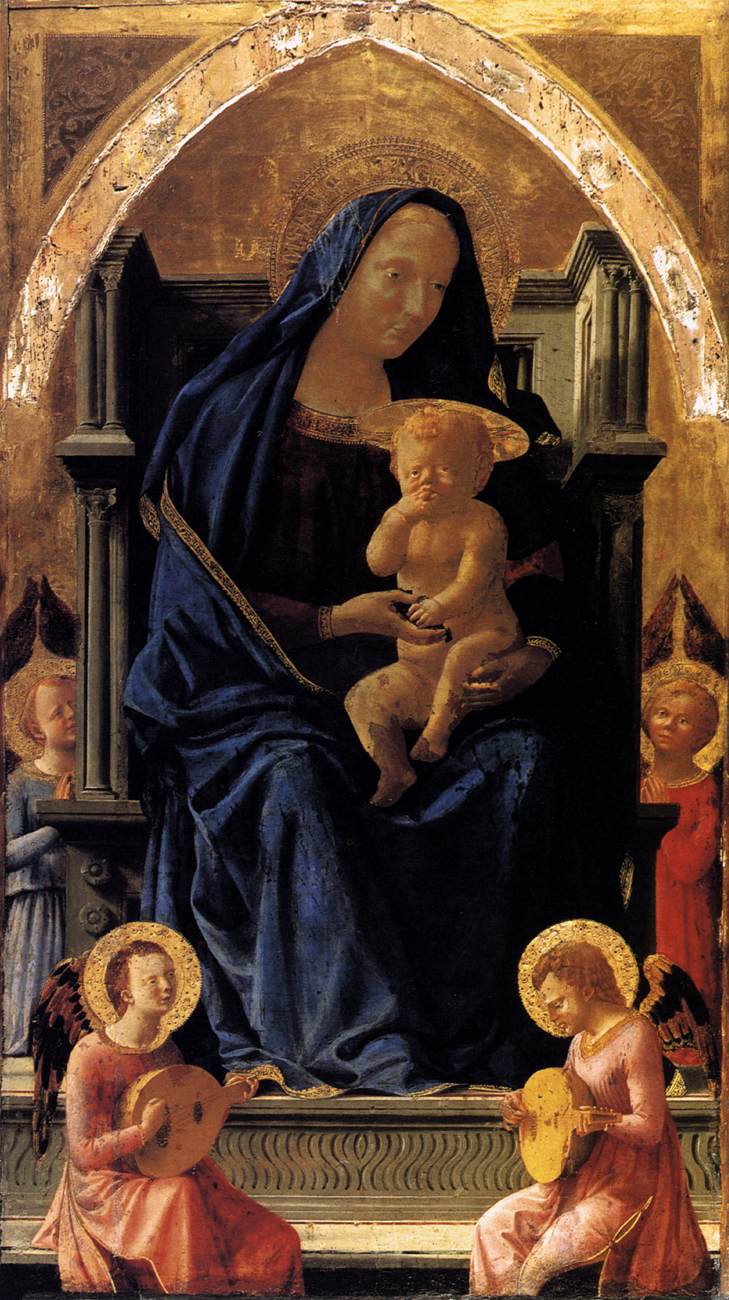
In 1424 the “duo preciso e noto” (“well and known duo”) of Masaccio and Masolino was commissioned by the powerful and rich Felice Brancacci to execute a cycle of frescoes for the Brancacci Chapel in the church of Santa Maria del Carmine in Florence. The theme of the frescoes in the little chapel was to be the “Histories of St. Peter”. The genius of Masaccio shows clearly in these frescoes. In the “Resurrection of the Son of Theophilus”, he painted a pavement in perspective, framed by large buildings to obtain a depth of field and three-dimensional space in which the figures are placed proportionate to their surroundings. In this he was a pioneer in applying the newly discovered rules of perspective.
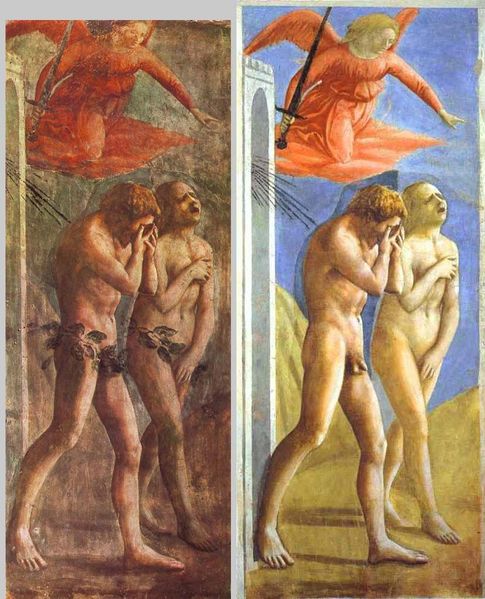
Masaccio’s scenes show his reference to Giotto especially. The Expulsion from the Garden of Eden, depicting a distressed Adam and Eve nude, had a huge influence on Michelangelo. Another major work is the Tribute Money in which Jesus and the Apostles are depicted as neo-classical archetypes.
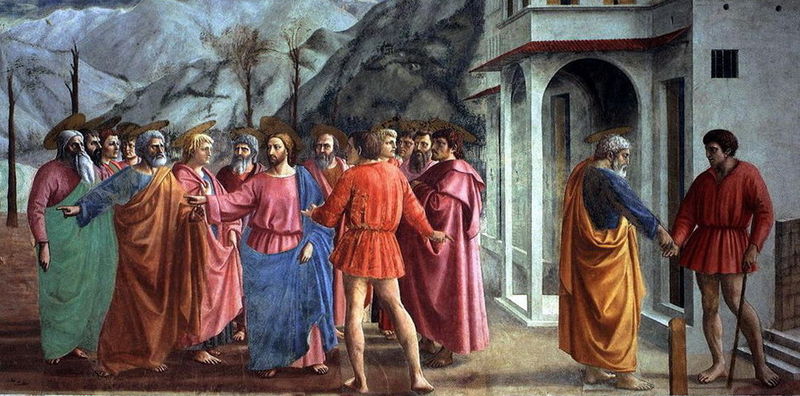
On September 1425 Masolino left the work and went to Hungary. It is not known if this was because of money quarrels with Felice or even if there was an artistic divergence with Masaccio. It has also been supposed that Masolino planned this trip from the very beginning, and needed a close collaborator who could continue the work after his departure.
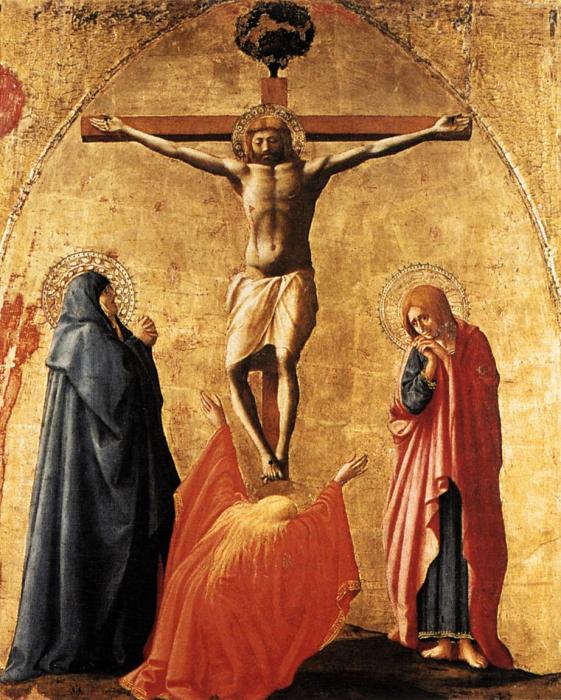
Some of the scenes completed by the duo were lost in a fire in 1771; we know about them only through Vasari’s biography. The surviving parts were extensively blackened by smoke, and the recent removal of marble slabs covering two areas of the paintings has revealed the original appearance of the work. Masaccio left the frescoes unfinished in 1426 in order to respond to other commissions, probably coming from the same patron. However, it has also been suggested that the declining finances of Felice Brancacci were insufficient to pay for any more work, so the painter therefore sought work elsewhere.
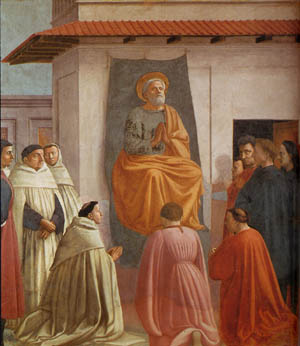
Masaccio returned in 1427 to work again in the Carmine, beginning the Resurrection of the Son of Theophilus, but apparently left it, too, unfinished, though it has also been suggested that the painting was severely damaged later in the century because it contained portraits of the Branacci family, at that time excoriated as enemies of the Medici. This painting was either restored or completed more than fifty years later by Filippino Lippi.
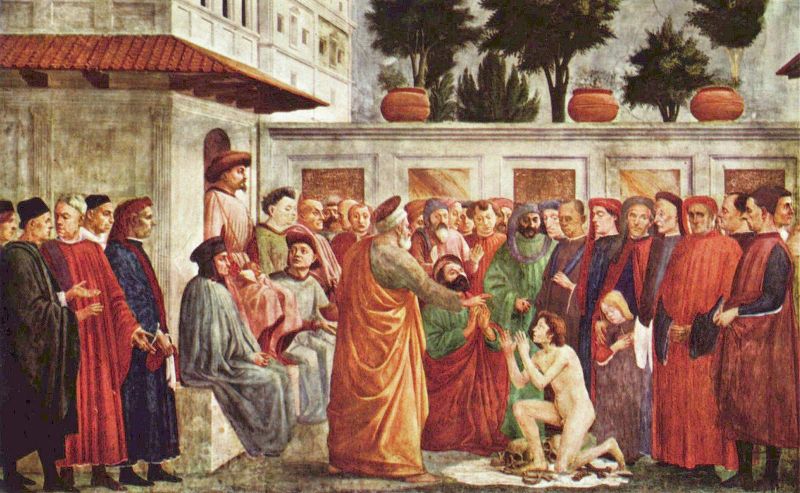
On February 19, 1426 Masaccio was commissioned by Giuliano di Colino degli Scarsi, for the sum of 80 florins, to paint a major altarpiece, the Pisa Polyptych, for his chapel in the church of Santa Maria del Carmine in Pisa. The work was dismantled and dispersed in the 18th century, and only eleven of about twenty original panels have been rediscovered in various places in the world. Masaccio probably worked on it entirely in Pisa, shuttling back and forth to Florence, where he was still working on the Histories of St. Peter. In these years Donatello was also working in Pisa at a monument for Cardinal Rinaldo Brancacci, to be sent to Naples. It has been suggested that Masaccio’s first ventures in plasticity and perspective were based on Donatello’s sculpture, before he could study Brunelleschi’s more scientific approach to perspective.
Through the help of Brunelleschi, in 1427 Masaccio won a prestigious commission to produce a Holy Trinity for the Santa Maria Novella church in Florence. The fresco, considered by many his masterwork, marks the first use of systematic linear perspective, possibly devised by Masaccio with the assistance of Brunelleschi himself.
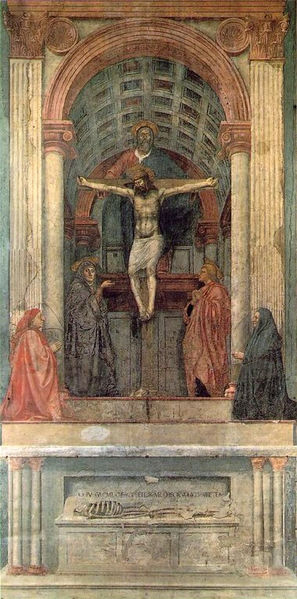
Masaccio produced two other works, a Nativity and an Annunciation, now lost, before leaving for Rome, where his companion Masolino was frescoing the Basilica di San Clemente. It has never been confirmed that Masaccio collaborated on that work, even though it is possible that he contributed to Masolino’s polyptych of the altar of St. Mary Major with his panel portraying St. Jerome and St. John the Baptist, now in the National Gallery of London. Masaccio died at the end of 1428. According to a legend, he was poisoned by a jealous rival painter.
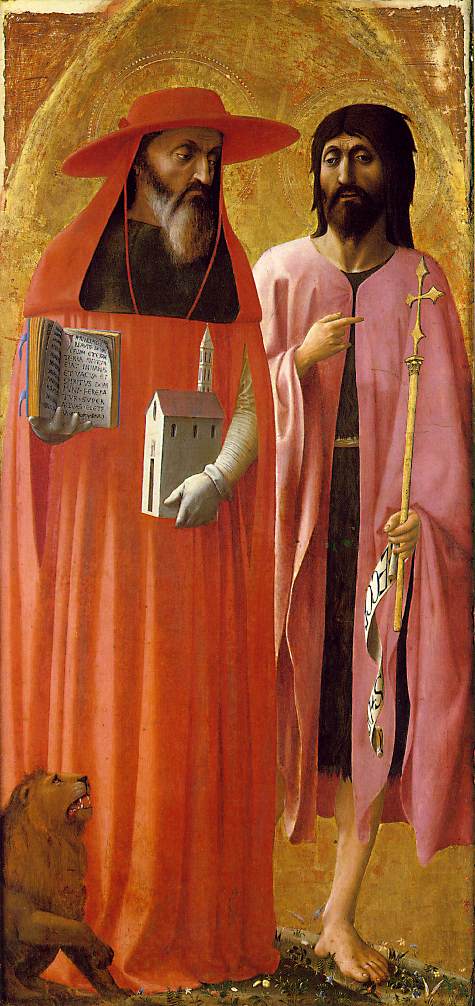
Only four frescoes undoubtedly from Masaccio’s hand still exist today, although many other works have been at least partially attributed to him. Others are believed to have been destroyed.
Masaccio profoundly influenced the art of painting in the Renaissance. According to Vasari, all Florentine painters studied his frescoes extensively in order to “learn the precepts and rules for painting well”. He transformed the direction of Italian painting, moving it away from the idealizations of Gothic art, and, for the first time, presenting it as part of a more profound, natural, and humanist world.
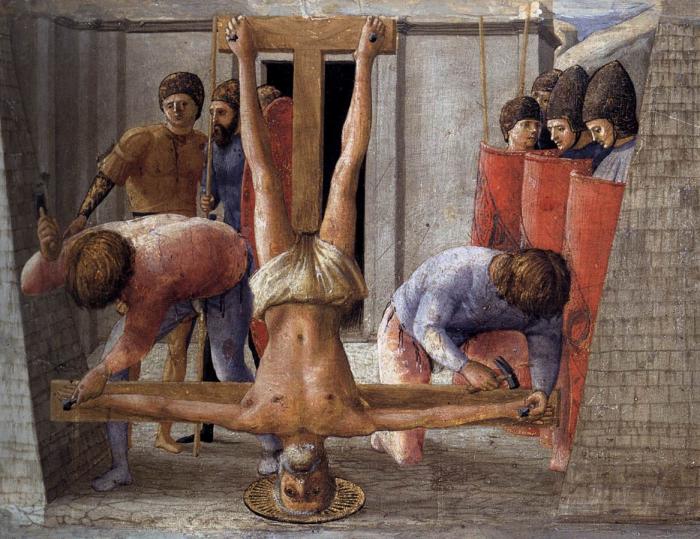
Still wondering about an Italian painting in your family collection? Contact us…it could be by Masaccio.
